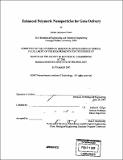| dc.contributor.advisor | Robert S. Langer. | en_US |
| dc.contributor.author | Green, Jordan Jamieson | en_US |
| dc.contributor.other | Massachusetts Institute of Technology. Biological Engineering Division. | en_US |
| dc.date.accessioned | 2009-01-30T16:29:50Z | |
| dc.date.available | 2009-01-30T16:29:50Z | |
| dc.date.copyright | 2007 | en_US |
| dc.date.issued | 2007 | en_US |
| dc.identifier.uri | http://hdl.handle.net/1721.1/44299 | |
| dc.description | Thesis (Ph. D.)--Massachusetts Institute of Technology, Biological Engineering Division, 2007. | en_US |
| dc.description | Includes bibliographical references. | en_US |
| dc.description.abstract | The potential of gene therapy to treat disease and improve human health is tremendous. The failure of viral gene therapy clinical trials due to toxicity, immunogenicity, and carcinogenicity has been tragic and strongly motivates a non-viral approach. However, non-viral gene delivery is currently ineffective. Here, we show that polymeric nanoparticles composed of poly([beta]-amino esters) (PBAEs) and DNA can be formulated to be stable in the presence of serum proteins and have high gene delivery without toxicity to human primary cells. The biophysical properties of PBAE/DNA nanoparticles have good correlation to transfection efficacy when tested in the appropriate media conditions. We also show that electrostatic interactions can drive peptide coating of nanoparticles and enable ligand-specific gene delivery. A biphasic efficacy relationship exists for peptide weight ratio, overall charge ratio, and ligand length, with intermediate values of coating being optimal. A balance is required when seeking to design nanoparticles that have reduced nonspecific uptake, but increased ligand-specific uptake. We develop a high-throughput assay to quantify polymer/DNA binding as a gene delivery bottleneck and find that a biphasic relationship exists between polymer/DNA binding constant, Ka, and delivery efficacy. We also show that end-modified PBAEs can be as effective as adenovirus for gene delivery. In comparison to the previous "gold standard" for polymeric transfection, 25 kDa polyethylenimine, the PBAE nanoparticles presented here have 100x higher efficacy while simultaneously having 100x lower toxicity. Small structural changes were found to have dramatic effects on multiple steps of gene delivery including the DNA binding affinity, nanoparticle size, intracellular DNA uptake, and final protein expression. | en_US |
| dc.description.abstract | (cont.) We show that small modifications to the termini of a polymer can significantly increase its in vivo activity and demonstrate potential utility of these polymers in the fields of cancer therapy, genetic vaccines, and stem cell engineering. As the enhanced polymeric gene delivery nanoparticles described here have many attractive properties over a virus including high safety, low immunogenicity, high nucleic acid cargo capacity, ease in manufacture, a coating method for targeted delivery, and flexibility for future design improvements, we believe that these polymeric nanoparticles may be promising alternatives for therapeutic gene delivery applications. | en_US |
| dc.description.statementofresponsibility | by Jordan Jamieson Green. | en_US |
| dc.format.extent | 228 p. | en_US |
| dc.language.iso | eng | en_US |
| dc.publisher | Massachusetts Institute of Technology | en_US |
| dc.rights | MIT theses are protected by copyright. They may be viewed, downloaded, or printed from this source but further reproduction or distribution in any format is prohibited without written permission. | en_US |
| dc.rights.uri | http://dspace.mit.edu/handle/1721.1/7582 | en_US |
| dc.subject | Biological Engineering Division. | en_US |
| dc.title | Enhanced polymeric nanoparticles for gene delivery | en_US |
| dc.type | Thesis | en_US |
| dc.description.degree | Ph.D. | en_US |
| dc.contributor.department | Massachusetts Institute of Technology. Department of Biological Engineering | |
| dc.identifier.oclc | 272382732 | en_US |
